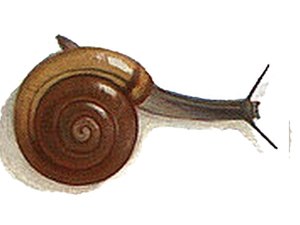British dagger snail
| British dagger snail | ||||||||||||
|---|---|---|---|---|---|---|---|---|---|---|---|---|

British dagger snail ( Zonitoides excavatus ) |
||||||||||||
| Systematics | ||||||||||||
|
||||||||||||
| Scientific name | ||||||||||||
| Zonitoides excavatus | ||||||||||||
| ( Alder , 1830) |
The British dagger snail ( Zonitoides excavatus ) is a terrestrial snail species from the family of the dagger snail (Gastrodontidae).
features
The right-hand winding case is flattened-conical, it measures 5.3 to 6 mm in width and 2.8 to 3.4 mm in height. There are (4½) 5½ regularly increasing, tightly wound and narrow walkways. The whorls are well arched on the periphery and separated from each other by a deep seam. The mouth is rounded, cut by the previous turn. It is inclined to the coil axis. The mouth edge is straight and tapered sharply. The navel is very wide and open in perspective. The housing is brownish, occasionally colorless or slightly greenish in color. The shell is translucent, the surface is shiny. It has strong growth strips.
The soft body of the animal is (rarely) light gray to almost black. the upper antennae are long and thin. The animals have a love arrow to stimulate their partner during copulation (name!), Who sits in a special arrow sack.
Similar species
The British dagger snail is smaller than the glossy dagger snail ( Zonitoides nitidus ) and has another navel. The shiny dagger snail also has slightly wider coils and a slightly larger mouth.
Geographical distribution and habitat
The distribution area extends from the British Isles , the coastal areas of the North Sea of Denmark, northern Germany, the Netherlands, Belgium and northern France to the Atlantic-influenced coastal areas of France, northern Spain and Portugal. In Germany, the species was also found in North Rhine-Westphalia and Lower Saxony in 2005, relatively far inland. All deposits are small and isolated.
The animals live in the litter and under dead wood of older forests, occasionally also in swamps, but basically on lime-free soils. Some authors even describe the species as extremely calciphobic . The species tolerates minor human interference in the forest ecosystem, but does not occur in sanctuaries or wood plantations.
Way of life
The eggs, which are enclosed in a lime shell, have a diameter of one millimeter. Two to six eggs (medium 3) are laid per clutch on or in the ground, in moss or rotting wood. Occasionally the eggs are also deposited individually. One clutch (or egg) is produced per day. The young hatch after 19 to 35 days with 1.4 to 2 coils. Sexual maturity is reached after four months. Egg cannibalism has also been observed on the part of the hatchlings. The observations were made in the laboratory under constant conditions.
Taxonomy
The taxon was first published in 1830 by Joshua Alder . It is generally recognized within the genus Zonitoides Lehmann, 1866.
Danger
The species is not endangered across its entire range. However, the few occurrences in Germany are at risk.
literature
- Michael P. Kerney, RAD Cameron, Jürgen H. Jungbluth: The land snails of Northern and Central Europe. 384 pp., Paul Parey, Hamburg & Berlin 1983, ISBN 3-490-17918-8 , p. 178.
Individual evidence
- ↑ Jürgen H. Jungbluth and Dietrich von Knorre: Trivial names of land and freshwater mollusks in Germany (Gastropoda et Bivalvia). Mollusca, 26 (1): 105-156, Dresden 2008 ISSN 1864-5127 , p. 122.
- ↑ a b c Vollrath Wiese: The land snails of Germany. 352 pp., Quelle & Meyer, Wiebelsheim 2014 ISBN 978-3-494-01551-4 (p. 166)
- ^ A b Francisco W. Welter Schultes: European non-marine molluscs, a guide for species identification = identification book for European land and freshwater mollusks. A1-A3 S., 679 S., Q1-Q78 S., Göttingen, Planet Poster Ed., 2012 ISBN 3-933922-75-5 , ISBN 978-3-933922-75-5 (p. 402)
- ^ A b Hajo Kobialka, Karl-Heinz Beckmann: Zonitoides excavatus (Alder, 1830) new for North Rhine-Westphalia (Gastropoda: Gastrodontidae). Malakologische Abhandlungen, 23: 97-107, 2005 PDF
- ↑ Elżbieta Kuźnik-Kowalska, BM Pokryszko: Selected aspects of reproductive biology of Zonitoides excavatus (Alder, 1830) (Gastropoda: Pulmonata: Gastrodontidae). Folia Malacologica, 20 (1): 57, Poznań, 2012 PDF
- ^ Joshua Alder: A catalog of the land and fresh-water testaceous Mollusca found in the vicinity of Newcastle upon Tyne, with remarks. Transactions of the Natural History Society of Northumberland and Durham, 1 (1): 26–41, London, 1830 Online at Biodiversity Heritage Library , p. 36.
- ↑ AnimalBase: Zonitoides excavatus (Alder, 1830)
- ↑ Fauna Europaea: Zonitoides (Zonitoides) excavatus (Alder, 1830)
- ↑ MolluscaBase: Zonitoides excavatus (Alder, 1830)
- ^ IUCN Red List of Threatened Species: Zonitoides excavatus
